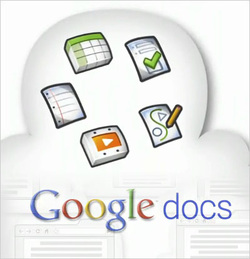
One component of education that is continually being encouraged is the idea of collaboration.
While I was in elementary, middle, and high school, collaboration simple met working with a partner on a project or going on a field trip with a class from another grade level. As I have learned today, however, collaboration means much more. Quoting Garth Holeman from Teachers For Tomorrow: "We need to start thinking big!" What does "big" mean? One look at the Teachers For Tomorrow website and you will begin to understand.
Google Docs
Today's class was all about Google Docs. If you have a g-mail account, you can use Google Docs. Interesting Facts: Its FREE and provides cloud computing, which virtually means an unlimited amount of storage space. If you're an educator, say (aloud or in your head) "Yippppie!" So how will using Google Docs help me develop collaboration?
Within Google Docs a person is able to simultaneously (and collaboratively) work on documents, presentations, spreadsheets, and forms without having to be in the same room, zip code, state, or country! Therefore, students can collaborate with experts virtually from anywhere in the world....all for free.
What are some ways I plan on using Google Docs?
While I was in elementary, middle, and high school, collaboration simple met working with a partner on a project or going on a field trip with a class from another grade level. As I have learned today, however, collaboration means much more. Quoting Garth Holeman from Teachers For Tomorrow: "We need to start thinking big!" What does "big" mean? One look at the Teachers For Tomorrow website and you will begin to understand.
Google Docs
Today's class was all about Google Docs. If you have a g-mail account, you can use Google Docs. Interesting Facts: Its FREE and provides cloud computing, which virtually means an unlimited amount of storage space. If you're an educator, say (aloud or in your head) "Yippppie!" So how will using Google Docs help me develop collaboration?
Within Google Docs a person is able to simultaneously (and collaboratively) work on documents, presentations, spreadsheets, and forms without having to be in the same room, zip code, state, or country! Therefore, students can collaborate with experts virtually from anywhere in the world....all for free.
What are some ways I plan on using Google Docs?
Documents: Using the documents component I can collaborate with another science or social studies teacher to create homework, formative and sumative assessments. I can also have my students from different periods work together on an assignment.
The YouTube video below provides more examples as to how teachers in the U.S. implement Google Docs in their classroom.
Presentations: Besides the obvious collaboration between different classes working on a presentation together, one idea that Garth shared with the class today made my ears jump: In the beginning of the year, my older science/social studies students can divide into groups and create a presentation that covers either 3rd, 4th, or 5th grade content. Then, as a class, we can Skype another school either in our district or elsewhere and share the presentations. What a creative way to review, create, and collaborate!
Forms: Looking for a quick and easy way to assess your students' comprehension? The forms components can be used to create pre-test, exit-slips, interest inventories, and more. Garth suggested having the school use the forms component for school events, such as school council elections. The really neat and useful aspect of using forms is the "summary response" option that tranfers all of the assessments into graphs.
NOTE: When using the forms component, it is best sticking with multiple choice, check box, and one word ansers.
Below is my first assessment:
Forms: Looking for a quick and easy way to assess your students' comprehension? The forms components can be used to create pre-test, exit-slips, interest inventories, and more. Garth suggested having the school use the forms component for school events, such as school council elections. The really neat and useful aspect of using forms is the "summary response" option that tranfers all of the assessments into graphs.
NOTE: When using the forms component, it is best sticking with multiple choice, check box, and one word ansers.
Below is my first assessment: